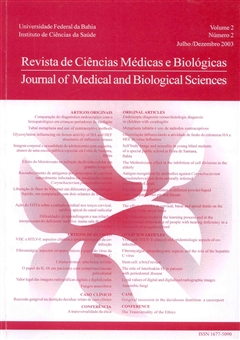Antigen recognition by antibodies against Corynebacterium pseudotuberculosis from naturally infected or immunized goats
DOI:
https://doi.org/10.9771/cmbio.v2i2.4286Keywords:
Corynebacterium pseudotuberculosis, ELISA, Western blotting.Abstract
Corynebacterium pseudotuberculosis is a gram positive bacillus, facultative intracellular pathogen of macrophages which is phylogenetically related with Mycobacterium tuberculosis. This pathogen is widely distributed in some animal species and is responsible for caseous lymphadenitis in sheep and goats. Caseous lymphadenitis is a widely spread chronic infectious disease, transmitted mainly through the skin. In the present experiment, aspects of the antigenic recognition by humoral response of goats bred in extensive condition, naturally infected or immunized with a live attenuated vaccine (cepa 1002, Empresa Baiana de Desenvolvimento Agrícola), have been studied. Samples of sera from immunized and control animals were collected monthly for a twelve month period and analyzed by ELISA and Western blotting. The analysis of the Western blotting results showed that the antigenic pattern recognized by sera antibodies of immunized animals is similar in crossbred or pure race animals and in naturally infected ones as well. Protein bands with molecular weights between 20 and 94 kDa have been detected. By analysing those samples, it was possible to observe that different proteins are recognized with elapsing time after immunization.Downloads
Download data is not yet available.
Downloads
Published
2003-01-01
How to Cite
Vale, V., Freire, S., Ribeiro, M., Regis, L., Bahia, R., Carminati, R., Paule, B. J. A., Nascimento, I., & Meyer, R. (2003). Antigen recognition by antibodies against Corynebacterium pseudotuberculosis from naturally infected or immunized goats. Journal of Medical and Biological Sciences, 2(2), 192–200. https://doi.org/10.9771/cmbio.v2i2.4286
Issue
Section
ORIGINAL ARTICLES
License
The Journal of Medical and Biological Sciences reserves all copyrights of published works, including translations, allowing, however, their subsequent reproduction as transcription, with proper citation of source, through the Creative Commons license. The periodical has free and free access.


